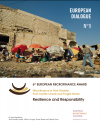Author: Gabriela Erice
In the framework of the 9th Convergences Forum, e-MFP organised a session on housing microfinance, a topic that, though not new (there are more than 20 years of practice in the sector), it is still rarely addressed within the financial inclusion community and the numbers are quite small, it only accounts for just 2% of MFI portfolios!
This little attention together with the fact that finance is strongly needed to support housing needs in developing countries, were the two very first things highlighted by the moderator, Daniel Rozas, e-MFP Senior Microfinance Expert, before giving the floor to the three panellists: Patrick McAllister, Senior Consultant at Habitat for Humanity & Representative of Habitat for Humanity's Center for Innovation in Shelter and Finance; Malkhaz Dzadzua, Chief Executive Officer, JSC MFO Crystal Georgia; and Sothany Chun, Chief Executive Officer, First Finance Cambodia.








0